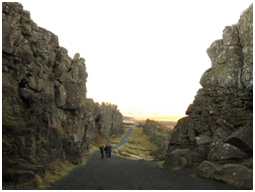Open Access Journal of
eISSN: 2575-9086


Opinion Volume 2 Issue 4
Professor and Researcher of the Tercio Pacitti Institute of the Federal University of Rio de Janeiro, Brazil
Correspondence: Joao Vicente Ganzarolli de Oliveira, Cidade Universit ria, Rio de Janeiro (RJ, 21941-901) 550, Brazil, Tel +5521- 3938-9600,
Received: August 07, 2018 | Published: August 13, 2018
Citation: Oliveira JVG. Edda heiðrún backman, flying in all latitudes. Open Access J Sci. 2018;2(4):287-288. DOI: 10.15406/oajs.2018.02.00088
This article results basically from personal impressions gathered during my visit to Iceland in 2013. In that occasion, I had the pleasure to know the Iceland artist Edda Heiðrún Backman, a distinguish member of the Association of Mouth and Foot Painting Artists of the World (AMFPA), founded by the German Arnulf Erich Stegmann (1912-1957). Some geological and cultural aspects of Iceland are also addressed in the lines that follow.
Keywords: Edda Heiðrún backman, Iceland, disability, art, geology, culture, happiness
No form of disability is an insurmountable obstacle for a person to attain happiness, uses to say the Brazilian Guilherme Ramalho, current president of ANDEF (Association of Disable People of the City of Niterói, Brazil). Such a truth becomes obvious when we consider the life of the Icelandic Edda Heiðrún Backman, whom I had the pleasure to meet in the year 2013 in the city of Reykjavík. Deceased in 2016, she was born in 1957 and stood out as singer, as well as theatre and film actress – in Iceland and abroad. Neurological and muscular problems started in 2003 draw her away from the stages and the screens; as the functioning of the lungs and the movement of the limbs became more and more compromised, the wheelchair became indispensable for her. Soon Edda realized that a door had been shut, but several windows remained open: her hands, immobilized by illness, were replaced, to some extent, by her mouth; Edda discovered the pottery, the glass and the oil painting. She also began to write stories for children, illustrated with her own watercolours. In all this, the rich cultural heritage of Iceland – a glacial country in which landscapes typical of the Moon and even the planet Mars can be seen with the naked eye1 – makes itself felt. One should not forget that the first concrete and effective experience of parliamentarism and democracy in the world took place on Icelandic soil more than 1,000 years ago, and that much of European medieval literature descends from the Edda, those ancient Icelandic poems dedicated to Teutonic gods and heroes.2

Some months ago (these lines have been written in August 2018), I learnt of Edda Heiðrún Backman’s death in 2016 through the owner of Eric the Red Guest House (the place in which I lived in 2013 during my stay in Reykjavík), who happens to be called “Edda” also – what, for obvious reasons, applies to quite a great number of Icelandic women. Coincidentally, during the same period, I was reading some excerpts from On the Love of the Poor, a treatise written by the Cappadocian thinker and saint Gregory of Nyssa (325 - 394), in which I found a passage that seems to have been written especially to Edda, the Icelandic artist confined to a wheelchair, and (why not say so?) to all of us. Here it is: “All the good deeds that you have done will reap celestial fruit. Don’t despair as a result of this saying, nor say that it is despicable to have a friendship with these people. The hand is mutilated but is not insensitive to assistance. The foot is gangrenous but always able to run to God; the eye is missing, but it discerns invisible goodness nonetheless, to the enlightenment of the soul. Don’t despise their misshapen body; yet a little while and you will contemplate a vision more astonishing than a complete miracle. Our frail nature is not prone to long-term endurance. As soon as there is no more weaving to be done on the corruptible and terrestrial body, the soul, delivered, will manifest its interior beauty”.3 The Mid-Atlantic Ridge literally runs through Iceland, placing its capital, Reykjavík, in the North American plate. In geological terms, Iceland is very young – just like humanity, if we compare it with the other inhabitants of Planet Earth. In Edda’s Heiðrún Backman work, there are plenty of references to the icy nature of the Arctic Circle region, economical in its variety of species, lavish in its number of individuals. She rejoiced especially in painting birds, inimitable representatives of freedom of movement and of overcoming frontiers of all kinds. For Edda, born in the far north, the flight of birds seemed to congregate the extreme poles of the existence, just like a symbol of opposites like suffering and joy, loss and conquest, past and present.
1See Ari Trausti Guðmundsson & Halldór Kjartansson. Lebende Erde. Facetten der Geologie Islands (translated from Icelandic to German by Richard Kölbi), Reykjavík, 2011. p. 9.
2See, for instance, José Pijoan et alii. Summa artis. Historia general del arte. Arte bárbaro y prerománico, desde el siglo IV hasta el año 1000, Madrid, Espasa Calpe, 1972, p. 31.
3Quoted by Almut Caspary (see “The Patristic Era”, in Disability in the Christian Tradition. A Reader [edited by Brian Brock and John Swinton], Grand Rapids, Michigan/Cambridge, UK, Eerdmans, 2012, p. 55).
None.
The author declares there is no conflict of interest.

©2018 Oliveira. This is an open access article distributed under the terms of the, which permits unrestricted use, distribution, and build upon your work non-commercially.